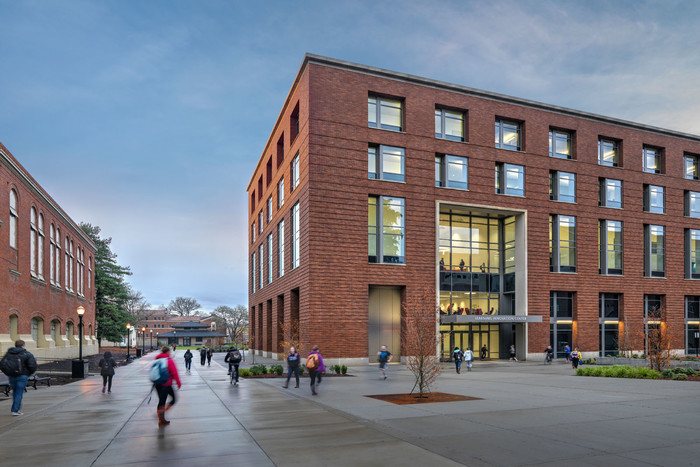Oregon State University’s classrooms in the round are located inside the Learning Innovation Center.
About 70 faculty members attended, including many department chairs and other academic leaders. Response system polling was conducted throughout the sessions to gather feedback. Some faculty members walked in skeptical and walked out supporters of the circular seating concept.
Supporting New Learning Spaces Requires the Right Infrastructure
Staff chose a flexible, standard network-based infrastructure for LINC to future-proof its presentation technology. Recognizing the growing reliance on real-time, network-based toolsets for supporting non-standardized teaching spaces, the team prioritized a scalable and adaptable network framework.
This approach avoids the limitations and costs associated with proprietary cabling and ensures compatibility with larger enterprise networks. By adopting widely accepted standards, LINC can seamlessly integrate current and emerging technologies.
DISCOVER: A network assessment is the first step in supporting today’s learning environments.
The network-based approach allows for easier updates and expansions, accommodating diverse teaching methodologies and tools as they develop. It also enables the infrastructure to support a wide range of devices and applications, enhancing the overall learning experience and operational efficiency within LINC environments.
Benefits of Teaching and Learning in the Round
There are many benefits of teaching and learning in the round, including:
- Enhanced engagement. When learners see the eyes and facial cues of their instructors and their peers, they are more likely to stay focused.
- Active learning facilitation. Increased learner and instructor proximity encourages active learning through robust discussions and activities that are more likely to promote a deeper understanding and retention of the content.
- Equitable seating. In OSU’s space, the podium in the center pivots a full 360 degrees. Without a typical “front” to the room, learners have increased opportunities for participation, and there is not a bad seat in the house.
LEARN MORE: Here’s how to design classrooms students want to use.
Tips for Completing a Successful Classroom Modernization Project
Designing modern, circular-seating classrooms with large enrollments presents unique challenges, but it also offers opportunities for innovative teaching and learning experiences.
If you are in the process of designing classroom spaces on your campus, here are some actions to consider taking:
- Design and test prototypes with stakeholders. Encourage involvement from all interested parties early in the design and planning phase, especially from instructors.
- Prioritize visibility. Ensure the instructor is visible throughout the classroom.
- Create a community of practice. A year before completion, invite potential instructors to participate in monthly sessions to initiate awareness, facilitate discussion and practice teaching in circular spaces.
- Conduct site tours before completion. This will allow faculty to get a feel for the space and envision how they might adapt their teaching methods.
- Provide one-on-one tech support. Invite faculty to rehearse in their scheduled spaces with the support of an IT professional who will help them become familiar with the room’s technology.
- Think about projection and screens. LINC’s 300- and 600-seat arenas feature 360-degree panoramic multimedia screens surrounding the audience, as well as eight projectors. We recommend using double-wide slides.
- Equip the room with state-of-the-art technology. Install extra conduits and cables throughout to accommodate future technology.
- Offer tours after completion. Inspire other institutions by offering tours to those that may want to deploy similar innovations. OSU has received visits from more than 100 institutions, many of which now have their own in-the-round learning spaces.
- Collaborate with institutions with similar innovations. We are aware of several institutions that have toured and were inspired by the LINC, which informed and impacted the design of their new classroom spaces. Those institutions include the University of California, Riverside; Texas A&M University ;and the University of Michigan. We are also collaborating with Roseman University, who initiated their in-the-round studio in 2012.
The OSU building project is unique in how its designers and project leads used a collaborative and inquisitive process from the beginning, which involved opportunities for instructors, students and other stakeholders throughout campus to share their ideas and advice and test prototypes.















